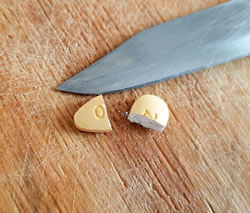You may want to cut a pill in half — maybe because you need a smaller dose, are trying to save on prescription costs, or have trouble swallowing larger pills. Rachel Fairbank advises.
 Cutting pills can be safe and effective, but there are a number of guidelines to make sure that you’re getting an effective dosage with each split pill. As pharmacists might say, “splitting a pill can be dangerous.”
Cutting pills can be safe and effective, but there are a number of guidelines to make sure that you’re getting an effective dosage with each split pill. As pharmacists might say, “splitting a pill can be dangerous.”
The risks of improperly cutting a pill include getting an improper dosage or changing the mechanism of how a pill works, such as changing it from extended-release (where the medication is slowly released into your system over a period of time) to one where it gets released all at once.
Discuss splitting a pill with your doctor or pharmacist first
Some pills are TGA approved for splitting.
Manufacturer guidelines for medications can change, which is why it’s important to discuss your plan to split your pills with your doctor or pharmacist first.
You can also find guidelines within the package insert included with your medication.
A scored line (usually) means a pill can be split
As chemists will point out, if a pill has a scored line in the centre, that’s a sign that it’s designed to be split in half. (There are exceptions, so double-check the instructions or ask your pharmacist to confirm.)
On the flip side, the absence of a scored line doesn’t necessarily mean that it can’t be split, but it’s a strong indicator that it probably shouldn’t.
If a pill does have a scored line and can be split in half, then you will want to cut along the line.
Capsules, which usually contain liquids or tiny beads, can never be split, as there is no good way to ensure an accurate dose.
The same is also true for tiny or asymmetrical pills, as there’s no good way to split them evenly.
Only split one pill at a time
It can be tempting to just go ahead and split an entire bottle of pills at once, to save yourself the hassle down the road.
However, as the TGA cautions, pills should be split one at a time, and only at the time of use, as split pills can be affected by heat or humidity, like in a bathroom environment.
Only cut one pill at a time, just before you need to take it, and be sure to use both halves before splitting the next pill.
Don’t split extended-release pills
Extended-release pills are designed to release the active ingredient over a period of time so that the effect of the medication is staggered.
This is in contrast to instant-release formulations, where the full amount of the active ingredient in a pill is released all at once. Depending on your particular needs, your doctor may prescribe one versus the other.
However, splitting an extended-release pill affects this mechanism, which can result in the medication being released all at once.
How to split a pill safely
If you do plan on splitting a pill, there are a number of safety practices to follow.
For starters, it helps to buy a pill cutter, which can help you split it more effectively than using a knife, which can cause the pill to fly across the room.
You also want to wash your hands beforehand and to wash the pill cutter between uses, especially if you’re cutting more than one type of pill.
* Rachel Fairbank is a freelance science writer based in the United States. When she is not writing, she can be found spending time with her family, or at her local boxing gym.











